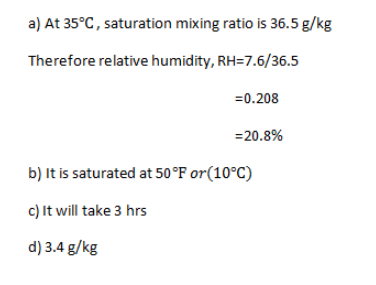The air inside a room is at a temperature of 35C and has a mixing ratio of 7.6 g/kg:
(a) What is the relative humidity?
(b) What is the dew point?
(c) If the room temperature decreases by 5Cper hour, how many hours will it take for the air to reach saturation?
(d) After reaching saturation, if the temperature of the room continues to decrease for one more hour, approximately how many grams of water vapor (per kg of air) will have had to condense out of the air to maintain to relative humidity of 100%?
Answer:

You might also like to view...
Manganese and phosphorite nodules can only be observed in areas of high sediment accumulation
Indicate whether the statement is true or false
When a beam of white light passes through a glass prism, it is separated into its component colors. What is this called?
A) diffraction B) dispersion C) selective scattering D) iridescence
In what region did a major tsunami strike in late 2004?
A) eastern Pacific Ocean B) western Pacific Ocean C) Mediterranean Sea D) Indian Ocean
Compared to the use of fossil fuels for generating electricity, wind energy ________
A) requires no investment B) is more consistent C) is not renewable D) is more widely used in the United States E) produces no exhaust pollutants and contributes little to global climate change